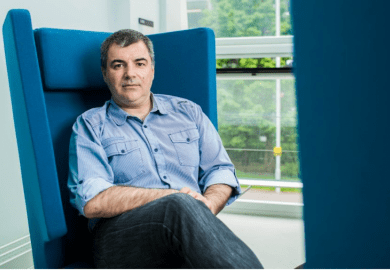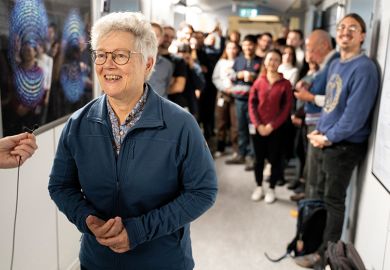In 1926, David Hilbert wrote: "From time immemorial, the infinite has stirred men's emotions more than any other question. Hardly any other idea has stimulated the mind so fruitfully. Yet no other concept needs clarification more than it does." Hilbert went on to assert that the infinite was "nowhere to be found in reality, neither [existing] in nature nor [providing] a legitimate basis for rotational thought"; in such circumstances how could we hope to build a sound understanding of its workings? He continued with a proposal to eliminate reliance on the infinite and other abstract ideas in the development of concrete mathematics.
Hilbert's remarks formed part of the reaction to contradictions arising within Georg Cantor's theory of infinite collections or sets. By the time that Hilbert made these remarks, axioms for set theory had been devised that blocked the contradictions. Nevertheless it appeared that intuitive principles identified in seemingly sound mathematical arguments were questionable; nothing less than the reliability of mathematical intuition concerning the infinite in particular, and the abstract in general, was in question.
Hilbert was surely right to emphasise the importance of the infinite to science and mathematics as well as the difficulty of reasoning sensibly with it. The extensive application of mathematics to the physical sciences in the 18th and 19th centuries rested on methods arising from the infinitesimal calculus of Isaac Newton and Gottfried Leibniz. Such methods provided for analysis of the variation in quantities dependent on others that are undergoing infinitely small variations themselves. Infinity was everywhere and the methods used to manipulate it were often unreliable.
Augustin Louis Cauchy and Karl Weierstrass, two of the greatest 19th-century mathematicians, are credited with the "elimination" of the infinitely small from analysis using the notion of a limit: a sequence of values approaches a limit if the successive values of the sequence come to differ from the limit by as little as one pleases as the sequence progresses. The methods that had proved so fruitful in practice were legitimate if applied to functions or series that were well behaved in ways defined using limits. A satisfactory account of limits, however, required a better understanding of the real numbers. Various definitions were subsequently suggested; all required the consideration of infinitely large collections of rational numbers. Infinity had returned with a vengeance: the infinitely small had been exchanged for the infinitely many.
It was in this setting that Georg Cantor began to study infinitely large collections of numbers. His set theory was based on the idea of counting. When we were children and could not count past three, we could still determine if there were enough toys to go round at a party by pairing each toy with a different friend. Cantor defined two collections to have the same size, or cardinality, if their members can be put in one-to-one correspondence, that is, paired successfully with each other. In 1874 he proved that the natural numbers could be paired with the rational numbers and that there are more real numbers than rational numbers, but not more than there are real numbers between 0 and 1. Counting beyond the finite, unlike counting beyond three, proves to be strange indeed.
Cantor said of his theory of sets that all of pure mathematics could be understood in its terms. In this he was surely right as any student of mathematics today will recognise. That this judgement was made so soon after the birth of the theory shows that Cantor understood that he had codified principles mathematicians were already using on a daily basis. The discovery of contradictions in this theory appeared to be a serious matter threatening to bring down the whole of the pure mathematical edifice.
In Understanding the Infinite Shaughan Lavine addresses the question of how we can have knowledge of the infinite. He meets the criticism of mathematical intuition concerning the infinite head on in the first half of the book by giving a careful summary of the development of set theory as a response to the need for a clearer theory of (functions on) the real numbers. What is particularly interesting in this presentation is Lavine's explanations of the intuition, or conception of set, motivating each principle introduced into the theory. Each principle is placed in its historical and mathematical context by drawing on the major historical and philosophical accounts of this development as well as on original material. Lavine stresses that Cantor's conception of set was that of a combinatorial collection that could be (well)-ordered, and hence counted by means of his transfinite symbols. This is contrasted with Frege and Russell's idea of a logical collection: the range of a propositional function, which was part of their attempts to base mathematics on logic. It is within theories of the logical conception of set that contradictions arise, not within Cantor's notion.
Cantor's conception was clear and free from contradiction. However, it was too weak for the purposes Cantor had in mind. Lavine describes how the principle of the power set - that the collection of sub-collections of any set is itself a set - was required to work adequately with the real numbers. But acceptance of such a principle was not justified on the basis of Cantor's notion of combinatorial collection. In fact, as Lavine explains, the power set principle introduced a different conception of set that rendered some of Cantor's other principles less than self-evident. Later, the power set principle was used as a basis for the iterative conception of set - the conception widely accepted today - advanced by Kurt Godel in 1947.
Lavine's treatment of this material manages to communicate the intellectual tension between competing conceptions commonly found at the frontiers of mathematics. He stresses the role of intuition and presents a view of mathematics as an activity where we manipulate ideas that stem from our experience, but which in their abstract form require intellectual capacities that appear to go beyond appreciation of direct experience.
It is to this latter point that the second half of the book is devoted. Here Lavine proposes to answer the question of how we can have sound intuitions about infinity based only on our actual experience of the finite. He develops a theory of the indefinitely large using recent mathematical work of Jan Mycielski on finite mathematics. The technical idea here is to introduce systematic ambiguity as to the size of the sets that objects are drawn from, leaving the context to provide the appropriate bounds. Lavine gives a general theory of the indefinitely large and an intriguing example where the theory is used to reconstruct an elementary argument in analysis in support of his claim that such ideas are capable of explaining the conceptions used when working with infinite quantities. Each of Cantor's principles is expressed in the theory and argued to be self-evident by appeal to the workings of the indefinitely large. The bold claim is then advanced that extrapolation of statements about the indefinitely large from dependence on their context is the mechanism that connects our experience of the finite yet indefinitely large with our intuition for the infinite.
Much of the first half of the book will be lost on those without a university education in mathematics. Lavine's attempts to explain the mathematical notions to the non-specialist ultimately fail. The logician, set theorist or historian of mathematics will find a refreshing emphasis, but little that is not present in more extensive treatments of the genesis of set theory. For those with interests in the philosophy of mathematics, however, this book is worth careful study. Lavine's preliminary analysis of the idea of context, and his use of this to advance the case that our understanding of the infinite rests on an appreciation of the properties of the indefinitely large, deserves consideration.
As we look back on a century in which abstract mathematics has flourished we find the infinite well and truly with us. I doubt we understand it any better than Cantor did, but our appreciation of its role in mathematics and our ability to work successfully with it have developed. An explanation of the basis for our abilities in this respect will no doubt occupy philosophers well into the next century.
Lincoln Wallen is a fellow, St Catherine's College, Oxford.
Understanding the Infinite
Author - Shaughan Lavine
ISBN - 0 674 92096 1
Publisher - Harvard University Press
Price - £31.95
Pages - 384pp
Register to continue
Why register?
- Registration is free and only takes a moment
- Once registered, you can read 3 articles a month
- Sign up for our newsletter
Subscribe
Or subscribe for unlimited access to:
- Unlimited access to news, views, insights & reviews
- Digital editions
- Digital access to THE’s university and college rankings analysis
Already registered or a current subscriber? Login



